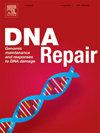Altered pathways in Cockayne syndrome: Involvement of MAPK, PI3K-Akt, extracellular matrix, inflammation, and neuronal signaling
IF 2.7
3区 生物学
Q2 GENETICS & HEREDITY
引用次数: 0
Abstract
Cockayne syndrome (CS) is a disorder characterized by neurodegeneration and a segmental progeroid phenotype, resulting from mutations in ERCC8/CSA or ERCC6/CSB genes. These genes encode proteins essential for the DNA repair pathway known as transcription-coupled nucleotide excision repair (TC-NER). To further investigate the biological pathways associated with this phenotype, we analyzed transcriptome datasets specific to CS. We conducted RNA-seq on the Csa-/- mouse model at three different age timepoints, and re-analyzed 8 microarray- or RNA-seq based CS transcriptomes present in Gene Expression Omnibus that contained appropriate isogenic controls. We identified differentially expressed genes in each dataset, which were subsequently used for pathway enrichment analysis. Our findings revealed that gene expression of CCL2 and VCAN was altered in the majority of the CS transcriptomes analyzed. Over-representation enrichment analyses of human CS transcriptomes revealed significant changes in genes related to the MAPK, ERK1/2, PI3K-Akt pathways, alongside pathways related to neuronal processes and extracellular matrix metabolism. Additionally, gene-set enrichment analysis of nervous tissue CS datasets highlighted terms related to inflammation and synapse biology. These pathways and processes may contribute to the neurological dysfunction and overall phenotype of CS, presenting promising avenues for future research into the etiology and potential treatments for this aging-related disorder.
Cockayne综合征的通路改变:MAPK、PI3K-Akt、细胞外基质、炎症和神经元信号的参与
Cockayne综合征(CS)是一种以神经变性和节段性类早衰表型为特征的疾病,由ERCC8/CSA或ERCC6/CSB基因突变引起。这些基因编码的蛋白质是DNA修复途径转录偶联核苷酸切除修复(TC-NER)所必需的。为了进一步研究与这种表型相关的生物学途径,我们分析了CS特异性的转录组数据集。我们对三个不同年龄点的Csa-/-小鼠模型进行了rna测序,并重新分析了基因表达Omnibus中包含适当等基因对照的8个基于微阵列或rna测序的CS转录组。我们在每个数据集中鉴定了差异表达基因,随后将其用于途径富集分析。我们的研究结果显示,在分析的大多数CS转录组中,CCL2和VCAN的基因表达发生了改变。人类CS转录组的过度表达富集分析显示,与MAPK、ERK1/2、PI3K-Akt通路相关的基因以及与神经元过程和细胞外基质代谢相关的通路发生了显著变化。此外,神经组织CS数据集的基因集富集分析突出了与炎症和突触生物学相关的术语。这些途径和过程可能导致神经功能障碍和CS的整体表型,为未来研究这种衰老相关疾病的病因和潜在治疗方法提供了有希望的途径。
本文章由计算机程序翻译,如有差异,请以英文原文为准。
求助全文
约1分钟内获得全文
求助全文
来源期刊

DNA Repair
生物-毒理学
CiteScore
7.60
自引率
5.30%
发文量
91
审稿时长
59 days
期刊介绍:
DNA Repair provides a forum for the comprehensive coverage of DNA repair and cellular responses to DNA damage. The journal publishes original observations on genetic, cellular, biochemical, structural and molecular aspects of DNA repair, mutagenesis, cell cycle regulation, apoptosis and other biological responses in cells exposed to genomic insult, as well as their relationship to human disease.
DNA Repair publishes full-length research articles, brief reports on research, and reviews. The journal welcomes articles describing databases, methods and new technologies supporting research on DNA repair and responses to DNA damage. Letters to the Editor, hot topics and classics in DNA repair, historical reflections, book reviews and meeting reports also will be considered for publication.
 求助内容:
求助内容: 应助结果提醒方式:
应助结果提醒方式:


